- Home | Arts & Culture |
- Kansas City’s Cruel Summer: The Flood of 1993
Kansas City’s Cruel Summer: The Flood of 1993 'Hard to Wrap Your Head Around'
Published June 29th, 2023 at 6:00 AM
Above image credit: While they came close, the flood of 1993 did not top the levees in the Central Industrial District on July 27, the same day the Missouri River crested just south of what is now Charles B. Wheeler Downtown Airport. (Courtesy | U.S. Army Corps of Engineers, Kansas City District).For months Kevin Carmichael brought back many of the “unknowns.”
Working with his father Darrel, the two operators of a towing service retrieved displaced caskets and burial vaults.
On July 12, 1993, Missouri River floodwaters inundated Hardin Cemetery, displacing 793 gravesites.
The Carmichaels later found them in farm fields and along fences.
“About 90 percent of them were burial vaults. But there were some caskets and bodies, too,” Carmichael said recently, standing in the Ray County cemetery, some 50 miles east of Kansas City.
“It was hard to wrap your head around.”
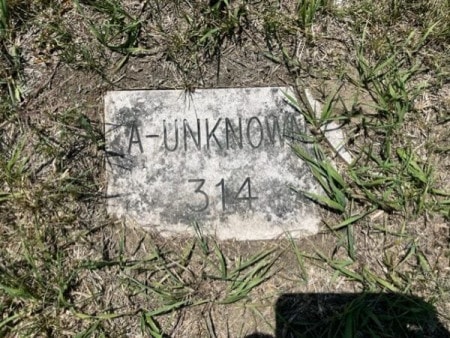
The Carmichaels and others ultimately recovered the remains of 645 people. A forensics mortuary team identified 120 of them.
Near the end, the Carmichaels helped re-bury the 525 unidentified remains in what was declared the “Unknown Section.” Today it’s a seemingly vacant field which, upon closer inspection, reveals itself to be a vast grid of small markers set down flush with the ground and displaying sequenced numbers.
“You know how when you go through something really hard with somebody and how that can create a bond?” Carmichael asked.
His co-workers, he said, had grown to trust one another enough to indulge in easy banter as they worked, just to distract them from their grisly task.
“But one of the last loads they brought in were all the babies,” he said. “So, the vaults were small.
“And for hours nobody said a word.”

Ruined Tequila
Call it Kansas City’s cruel summer.
Many floods occur in the spring, a product of snowmelt runoff sometimes compounded by heavy rains that stress the Missouri River watershed.
Thirty years ago, the Flood of 1993 came late and stuck around.
“No other natural disaster in U.S. history affected or touched so many lives for so long a duration as did the Midwest Flood of 1993,” reads a U.S. Army Corps of Engineers report published the following year.
Severe or record flooding occurred across a nine-state area.
Rare meteorological patterns produced a “convergence zone” that parked over the Upper Midwest, prompting biblical rains. From April through July, more than 30 inches fell in central Kansas and northern Missouri. July 1993 became the second wettest July for Kansas since 1885, and the third wettest for Missouri.
“What is hard for a lot of people to understand is the Flood of 1993 seemed to last forever,” said Jud Kneuvean, readiness and contingency operations chief for the U.S. Army Corps of Engineers, Kansas City District.
“We started work on July 4 weekend, and we were doing our damage assessments on Labor Day.”

On July 10, the Kansas River spilled over near 59th Street and Kaw Drive in Wyandotte County, displacing residents of mobile home communities.
Many families received aid at a temporary American Red Cross shelter, while also meeting with volunteer mental health therapists before the water receded in their neighborhoods and they returned to their homes, only to have the river arrive at their doors again nine days later.
Also on July 10, Turkey Creek flooded Southwest Boulevard, leaving water standing several feet high in many businesses and restaurants, among them Ponak’s Mexican Kitchen and Margarita’s.
At dawn firefighters in boats rescued employees from both.
Also on July 10, just southwest from what is now Charles B. Wheeler Downtown Airport, the paddle-wheel river dredge William S. Mitchell tore loose from its moorings and began what the Corps post-flood report called “a spectacular, out-of-control journey down the Missouri River, colliding with a barge, two railroad bridges and three highway bridges.”
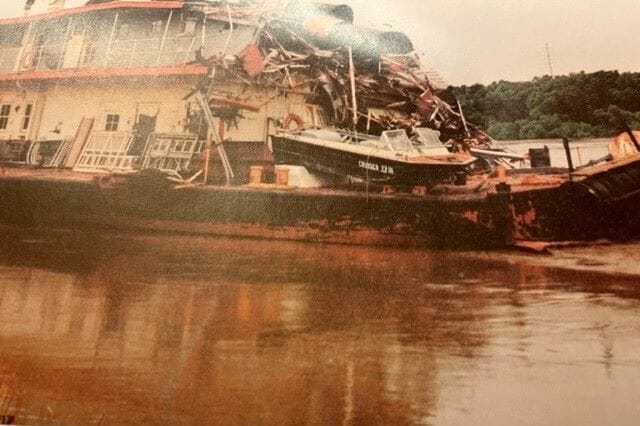
Crew members of a “line boat,” used to pull barges upstream, chased the dredge for three miles before securing it.
On July 12, the Missouri River came over the levee at Hardin and scoured a trench through the middle of the cemetery, about a mile away. Even today a small pond stretches through the middle of the burial ground.
And on July 27, the Missouri River crested in Kansas City, coming within inches of overtopping the levees protecting the downtown airport.
When it was over, there were many ways of measuring what happened.
8,000 cubic feet per second.
That was the approximate volume of water the Turkey Creek tunnel beneath Interstate 35 could accommodate in 1993, said Chance Bitner, hydrologic engineering branch chief for the U.S. Army Corps of Engineers, Kansas City District.
“The peak flows on Turkey Creek in 1993, as well as during a separate flood event in 1998, were pretty close to 19,000 to 20,000 cubic feet per second,” Bitner said.
“That’s why so much water pushed down into Southwest Boulevard.”
100 cases of tequila.
That’s how much flood-ruined tequila John Greer, general manager of Ponak’s Mexican Kitchen & Bar, had to destroy under the watchful eye of agents from what is now the Bureau of Alcohol, Tobacco, Firearms and Explosives (ATF).
“I had organized all the food and laid it out behind the restaurant, categorized it and photographed it for the insurance companies, and then threw all of it into the dumpster,” Greer said
“Then I had the ATF come out and they sat there and watched as I broke all the bottles of tequila to make sure all that liquor was broken in their presence.
“With the rotting food and heavy scent of tequila, it was a hell of a smell by the fourth day.”
Over 750.
That’s the approximate number of flood-affected families from across Wyandotte County estimated to have lost their homes during the flood, among them many in mobile home communities along the Kansas River.
“Hundreds of homes were completely submerged and later condemned, according to “Stories of Survival: Voices from the Wyandotte County Floods of 1993,” a post-flood summary detailing the aid given flood victims by county mental health professionals. “Many never returned.”
152.
That’s how many river levees were breached, damaged or affected in the Kansas City area, contributing to the rise of Missouri River water in Parkville and Riverside just northwest of Kansas City and Levasy — and then Hardin — to the east.
$529 million.
That’s the figure quoted by the U.S. Army Corps of Engineers, Kansas City District to describe the investment since made in the Kansas Citys Levee Project, which includes upgrades to existing levees and floodwalls along both banks of the Missouri and Kansas rivers in the Kansas City metro area.
The project — started some 15 years ago and expected to be completed by 2026 — is separate from the complimentary Turkey Creek flood control project, which began in 2004 and is expected to be completed by 2026. That will upgrade flood protection, expelling water into the Kansas River upstream from where the Kansas Citys Levee Project work begins. The Turkey Creek investment totals $160 million.
The high water prompted behavior both admirable and less so.
Missouri Attorney General Jay Nixon, during a late-July news conference in Kansas City, warned trailer park residents about those seeking to gouge mobile homeowners when moving their trailers.
“As the water recedes, the scam artists tend to come in,” Nixon said.
During the first nights after the flood, Greer posted guards at his restaurant.

“I had to worry about physical property being stolen,” Greer said. “I had ovens and ice machines waiting outside to be picked up and refurbished.”
But the Southwest Boulevard story also attracted the generous. For close to three weeks colleagues in the Kansas City area restaurant industry sent free lunch and dinners to Margarita’s employees working day and night shifts to restore the restaurant.
“There was pizza from Minsky’s, pasta from Italian Gardens, and bags of hamburgers from Town Topic,” said Dave Quirarte, Margarita’s owner. The restaurant’s longtime purveyors and suppliers also sent free food, and when Margarita’s opened 60 days later, the restaurant reciprocated.
“For the first few days we fed all of those people for free,” Quirarte said.
Flood of 1993 Lessons
On or about July 10, the Wyandotte County Chapter of the American Red Cross set up a shelter for those displaced by high water and circulated a call for mental health volunteers.
Among the therapists who reported there was Randy Callstrom, today president and chief executive officer of the Wyandot Behavioral Health Network.
While the Red Cross representatives coordinated immediate food and clothing relief for flood victims, Callstrom’s role was to allow the displaced to be heard.
There was plenty to be discouraged about.
On July 10 and then again on July 19, high water from the Kansas River had inundated several mobile home communities near the intersection of 59th Street and Kaw Drive.
Many of the displaced had been experienced river watchers who had seen high water before only to watch it recede from their trailers.
“For the most part the ones we interacted with were just in initial shock,” Callstrom said. “They had lost everything, and our role was supporting them in that moment.”
While the Kansas River left discouraged homeowners, Turkey Creek, which flooded on July 10, left angry business owners.
“We received really intense rains on the order of three and a half inches pretty fast and that led to the overflow of Turkey Creek,” said Chance Bitner of the Corps of Engineers.
Turkey Creek had flooded several times in the early 1900s.
In 1918, to redirect the creek water to the Kansas River, workers began boring a tunnel underneath a bluff known as Greystone Heights. They finished the 1,450-foot tunnel, 28 feet wide and 32 feet high, two years later.
“It was an engineering marvel at the time,” said Greer of Ponak’s.
But the tunnel couldn’t handle the water that arrived in 1993.
When he was finally able to get into the restaurant, Greer adopted the restaurant flood-recovery wisdom of his brother Stephen, who had been serving as area general manager of the Gilbert/Robinson restaurants in the Country Club Plaza during the district’s 1977 flood.
“First, I knew we needed to get the inch of mud off the floor while it was still moist,” he said.
“If that mud hardens, it’s like rock.”
On July 11, after much of the water had receded, Kansas City Mayor Emanuel Cleaver led a touring party of the Turkey Creek damage. It included stops at then-Kemper Arena and the American Royal complex, where an electrical transformer had failed after being overwhelmed by Turkey Creek water, cutting power to a nearby pump station and resulting in water covering floors in both buildings.
Another stop: Ponak’s.
“I was the only one who was nice to the mayor,” Greer said. “Everybody else on the boulevard was angry with him.”
Business owners on the boulevard, Greer said, were frustrated at their livelihoods being underwater.
“But it was also about how Southwest Boulevard sometimes seemed forgotten, even though it was one of the main ways into the city,” Greer said.
Meanwhile, work had begun two years before on an $86 million Brush Creek flood project, in response to the high water that in 1977 inundated 77 of the Plaza’s 155 businesses.
“It’s like Southwest Boulevard is the city’s forgotten stepchild,” the owner of a flooded commercial building told a Kansas City Star reporter on July 10.
“The Country Club Plaza gets protected, the big bucks get protected, but down here — nothing.”
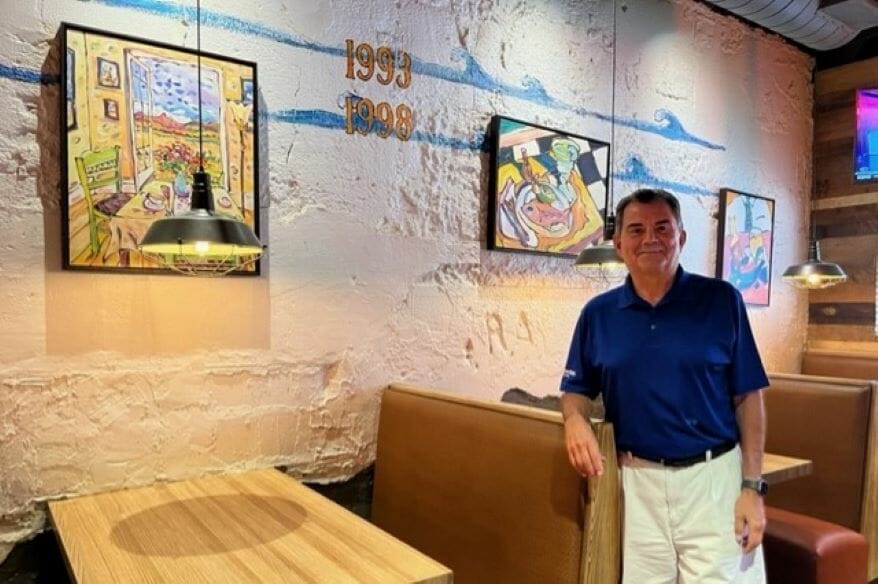
The 1977 Flood had affected more than the Plaza. The high water caused an estimated $100 million in damages across the Kansas City area and killed 25 people, with victims recovered from Leavenworth to Leawood to Independence — as well as in a Plaza parking garage.
Days after his Southwest Boulevard tour, Cleaver heard the same complaint from a City Council member, prompting the mayor to say he had made three trips to Washington to testify before congressional committees, advocating for Turkey Creek flood control.
“It’s not like we’re just sitting around and deciding to let Southwest Boulevard flood,” Cleaver said.
A similar flood hit Southwest Boulevard in 1998.
But in 2004 work began on the Turkey Creek flood control project.
“We’re on the road to recovery,” Cleaver, then a member of Congress, said during a 2009 ceremony celebrating the restoration of the 1920 tunnel.
Greer is confident in the work now being done by the corps, and is impressed with the new flood-control infrastructure visible just south of Interstate 35 near South Seventh Street.
“In 1993 the water came straight down the railroad tracks and there was nothing to block it,” Greer said.
“But if you look there today you will see how high that earthwork is. That’s an awfully high dike for water to get over.
“It would have to be a really, really, really heavy rain.”
Matter of Inches
On July 3, a flood emergency was declared to exist within the Corps of Engineers’ Kansas City District, which encompasses much of northern Kansas and western Missouri, and portions of Iowa, Nebraska and Colorado.
“I was only a year into my career,” said Kneuvean of the Corps of Engineers.
“I was working at a field office down at Napoleon and when we first got called for flood duty my first thought was, ‘Wow, I finally get to see the Corps of Engineers in action.’
“My dad had retired from the organization, and I remember as a kid him deploying for disasters.”
Kneuvean wasn’t disappointed.
“I was bouncing up and down the river, interacting with our levee partners who were having problems. There was more water than their levees could take.”
On July 27, when the Missouri River crested in Kansas City, Kneuvean was on duty at the downtown airport.
“All the planes had been evacuated and there was only a handful of us, running a 24-7 pumping operation,” he said.
The problem: a pumping plant near the end of one runway had failed. Water underneath the plant had undermined it, causing it to settle several feet into the earth, making it inoperable.
There was more at risk than the airport. Some worried if the water came over the levee, it wouldn’t stop and perhaps threaten the Kansas City water treatment plant not far to the north.
Kneuvean and his colleagues, working with temporary emergency pumps, kept the water out — but not by much.
“It came within inches of overtopping,” he said.

Throughout the night, alternative scenarios had been pondered by Kneuvean his colleagues, which included city airport employees and Kansas City police officers maintaining traffic barriers.
“At the airport, whether you went upstream or downstream there, there really were no good alternatives,” Kneuvean said.
“If water had started going over the top, we would have had to abandon our efforts and leave. We would have had the opportunity to jump in our vehicles, drive around and hop up on the Broadway Bridge.
“That would have been our best option.”
By mid-afternoon on July 27, the water had receded about six inches. The airport reopened on Aug. 4.
By then Kneuvean had been reassigned downstream, reading hourly river stages at Hermann, Missouri.
But the flood made an impact on him.
“I always tell people that the 1993 Flood made my career,” said Kneuvean. “It’s the event that convinced me that I wanted to work in the Corps of Engineers.
“When you do disaster response and recovery, your impact is immediate. You are trying to help folks get back on their feet and resume their normal lives.
“But it also made me want to work with our partners in Missouri and Kansas, preparing and improving their levees, and I have been doing that for most of my career since.
“It’s what I was really meant to do.”
Flood Legacies
While levees in the immediate Kansas City area performed well, some sections did not perform as well as expected, said Bitner, Kneuvean’s colleague.
“When we did reviews after the 1993 Flood, the flood levels — especially on the Kansas River portions of the levees — were higher than we expected,” Bitner said. “There were locations on the Armourdale levee where the water had been within 1.5 feet from the top of the flood wall.
“So that was definitely a motivating factor for re-looking at the heights of the levee system there.”
Among those benefitting today from levee upgrades in the burgeoning West Bottoms district are the entrepreneurs developing the Rock Island Bridge — a railroad bridge built in 1905 — into a unique entertainment district and public trail crossing that is expected to be complete in a year.
“The Corps of Engineers knows how to hold back water,” said Mike Zeller, one of the project partners.
“I don’t see any reason not to have confidence in its work.”
The bridge will be the anchor of a new recreational district that will feature facilities for boating and cycling enthusiasts. The completed project, Zeller said, will prompt Kansas City area residents to reimagine the river many may have grown indifferent to.
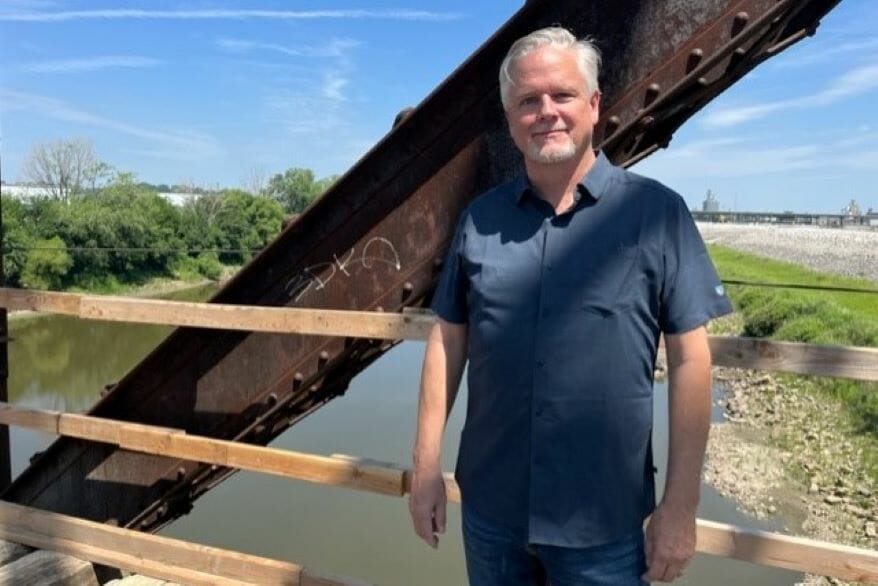
“About 130 years ago when we were building the stockyards down here, we were using the Kansas River as an industrial river,” Zeller said.
“But this is the same river that goes through Lawrence and Wamego and Manhattan, and is thought of very differently there. Energy follows attention, and the Rock Island Bridge soon will have 600,000 to 800,000 people a year listening to live music on the Kansas River.
“This is the start of re-branding the Kansas River from that 19th century industrial river to a 21st century recreational river.”
Meanwhile, for Wyandotte County mental health professionals, the 1993 Flood represented a lesson in crisis response, said Callstrom.
The Wyandot Behavioral Health Network since has become part of the Wyandotte County emergency operations plan, he said, and in that role has responded to other emergencies, such as a tornado that struck Wyandotte County in 2003 and the 2004 shooting deaths of four employees and the wounding of several others by a disgruntled employee of the ConAgra Foods Inc. plant in the Argentine District of Kansas City, Kansas.
“Today we have a whole crisis team, and they are all trained in an evidence-based model called ‘crisis intervention management,’ which is a more structured approach to working with individuals who have experienced trauma,” Callstrom said.
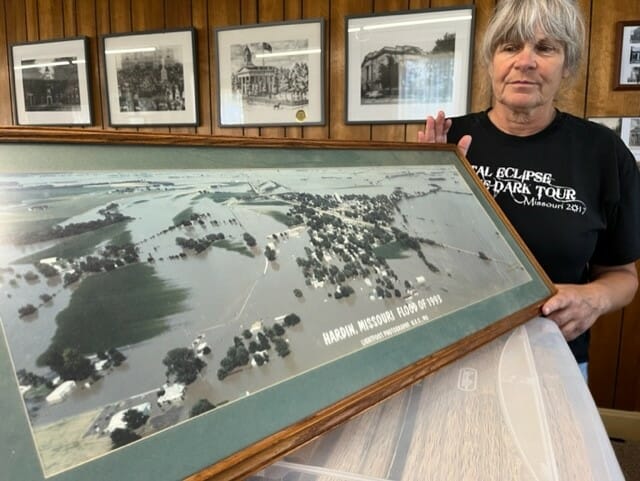
Among long-time Ray County residents, the trauma of the Hardin Cemetery flooding has remained just below the surface for the past 30 years, said Cathy Gottsch, administrator of the Ray County Museum in Richmond, Missouri, just west of Hardin.
“But bring that topic up and everybody will tell you how it affected them or their families,” Gottsch said. She currently is considering a program on the tragedy to observe its 30th anniversary.
“People will want to talk to their kids about it,” she said.
For Kevin Carmichael of Ray County, he believes the 1993 flood changed him in subtle and profound ways. State emergency officials, impressed with the work he and his father did during the Hardin Cemetery flood, offered them roles on the state’s disaster mortuary operational response team.
“We thought at first it was some kind of honorary role,” Carmichael said.
It wasn’t. Both responded to New York after the 2001 terrorist attacks. A veteran of Operation Desert Storm, the younger Carmichael thought he had been sufficiently schooled in crisis and response.
“My father and I have worked car crashes our whole lives, and been around a lot of awful things,” Carmichael said. “Maybe Hardin Cemetery was just one more step in the things we had to deal with.”
Faith played a role in getting them both through the experience, he added.
“We’re both believers, so we leaned on our religion and our families.
“Nobody is strong enough on their own.”
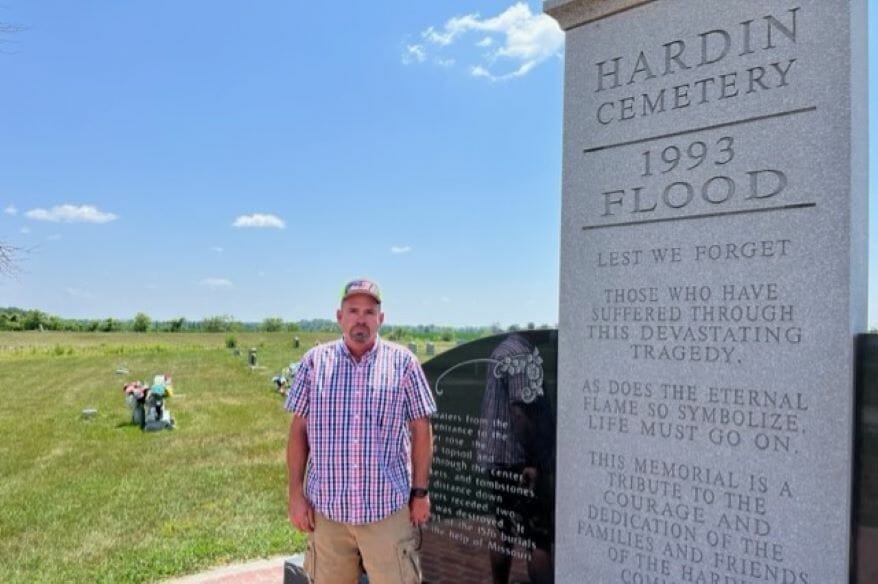
Flatland contributor Brian Burnes served as a Kansas City Star reporter from 1978 through 2016.
Like what you are reading?
Discover more unheard stories about Kansas City, every Thursday.
Thank you for subscribing!
Check your inbox, you should see something from us.
Ready to read next


